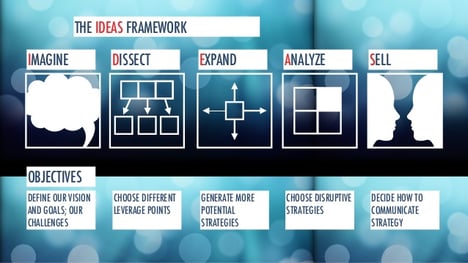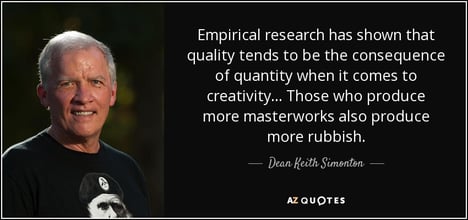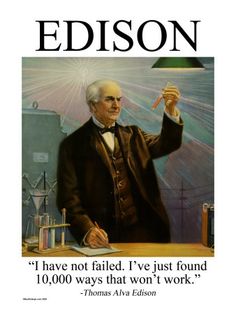In How Originals Identify Innovative Ideas I promised to share ideas on how you can improve your batting average to generate innovative products and services for your business.
 In Kaihan Krippendorff’s Outthink the Competition: How a New Generation of Strategists Sees Options Others Ignore, he provides these 5 steps to achieving Disruptive Innovations.
In Kaihan Krippendorff’s Outthink the Competition: How a New Generation of Strategists Sees Options Others Ignore, he provides these 5 steps to achieving Disruptive Innovations.
In these steps, Krippendorff incorporates several methods Originals author, Adam Grant, suggests to overcome the challenges to developing winning ideas.
How to Eliminate Bias in Winning Moves?
To improve your ability to choose winning moves you need to overcome your bias. How do you achieve this?
 Creators are terrible at judging how their performances do with the test audiences.
Creators are terrible at judging how their performances do with the test audiences.
Social scientists have long known that we tend to be overconfident when we evaluate ourselves. Here are some highlights from their findings:
- High school seniors: 70 percent report that they have “above average” leadership skills, compared with 2 percent “below average”; in the ability to get along with others, 25 percent rate themselves in the top 1 percent, and 60 percent put themselves in the top 10 percent.
- College professors: 94 percent rate themselves as doing above-average work.
- Engineers: In two different companies, 32 percent and 42 percent rated themselves among the top 5 percent of performers.
- Entrepreneurs: When 3,000 small-business owners rated the probability that different companies would succeed, on average they rated the prospects of their own businesses as 8.1 out of 10 but gave similar enterprises odds of only 5.9 out of 10.
Genius Error Rates
Do you consider yourself in the genius category?
Even geniuses misjudge their talent. Psychologist Dean Simonton, whose career studies creative productivity, discovered Beethoven, Shakespeare, Picasso, and Edison, had difficulty recognizing when they had a hit on their hands. Beethoven was known as a perceptive self-critic, yet as Simonton observes, “Beethoven’s own favorites among his symphonies, sonatas, and quartets are not those most frequently performed and recorded by posterity.” In Originals Grant notes, “In one analysis, psychologist Aaron Kozbelt pored over letters in which Beethoven evaluated seventy of his compositions, comparing those appraisals to expert judgments of Beethoven’s works. In that set of seventy, Beethoven committed fifteen false positives, expecting pieces to be major that turned out to be minor, and only eight false negatives, criticizing pieces that ended up becoming highly valued. This 33 percent error rate occurred despite the fact that Beethoven made many of his assessments after receiving audience feedback.”
When Picasso painted his famous Guernica in protest of fascism, he produced seventy-nine different drawings. Many of the images in the painting were based on his early sketches, not the later variations. “The subsequent sketches proved to constitute ‘blind alleys’ in which the artist did not know in advance that he was taking the wrong track,” Simonton explains. If Picasso could judge his creations as he produced them, he would get consistently “warmer” and use the later drawings. In reality, it was just as common he got “colder.”
 You’re probably familiar with a small number of Shakespeare’s classics. In the span of two decades, Shakespeare produced 37 plays and 154 sonnets. Simonton tracked the popularity of Shakespeare’s plays, measuring how often they’re performed and how widely they’re praised by experts and critics. In the same five-year window that Shakespeare produced three of his five most popular works—Macbeth, King Lear, and Othello, he also produced average titles, Timon of Athens and All’s Well That Ends Well, which rank among the worst of his plays.
You’re probably familiar with a small number of Shakespeare’s classics. In the span of two decades, Shakespeare produced 37 plays and 154 sonnets. Simonton tracked the popularity of Shakespeare’s plays, measuring how often they’re performed and how widely they’re praised by experts and critics. In the same five-year window that Shakespeare produced three of his five most popular works—Macbeth, King Lear, and Othello, he also produced average titles, Timon of Athens and All’s Well That Ends Well, which rank among the worst of his plays.
Simonton reports the most prolific people not only have the highest originality; they also generate their most original output during the periods in which they produce the largest volume. Between the ages of thirty and thirty-five, Edison pioneered the lightbulb, the phonograph, and the carbon telephone. But during the same period, he filed well over one hundred patents for other inventions, few that ever became successful.
 Thomas Edison noted, “To get a great idea, come up with lots of them.”
Thomas Edison noted, “To get a great idea, come up with lots of them.”
“Those periods in which the most minor products appear tend to be the same periods in which the most major works appear,” Simonton notes. Edison’s “1,093 patents notwithstanding, the number of truly superlative creative achievements can probably be counted on the fingers of one hand.”
Conclusion: “The odds of producing an influential or successful idea,” Simonton notes, are “a positive function of the total number of ideas generated.”
It’s widely assumed that there’s a tradeoff between quantity and quality, “if you want to do better work, you have to do less of it.”
This turns out to be false.
In fact, when it comes to idea generation, quantity is the most predictable path to quality. “Original thinkers,” Stanford professor Robert Sutton notes, “will come up with many ideas that are strange mutations, dead ends, and utter failures. The cost is worthwhile because they also generate a larger pool of ideas—especially novel ideas.”
Expand: Outthinker Process Produces Lots of Ideas
The Ideas Framework for the Outthinker Process, step two and three are Dissect and Expand. Krippendorff intentionally asks you to dissect 5-8 different strategies and tactics, each time requiring your team to develop 5 different ideas for each strategy. A small team of 4 will generate 20 ideas for each of these strategies, producing a minimum of 100 ideas. If you’re team is creative, it can be much more.
.jpg?width=468&height=288&name=IDEAS-Framework%20From%20This%20to%20This%20(Outthink%20Competition).jpg) In Dissect and Expand, you’re achieving lots of ideas, to reduce your bias, boosting the probability of producing a winning move.
In Dissect and Expand, you’re achieving lots of ideas, to reduce your bias, boosting the probability of producing a winning move.
The Outthinker process next step, requires a small tweak to produce better ideas. We’ll explore, next blog.
Growth demands Strategic Discipline.
Positioning Systems helps mid-sized ($5M - $250M) business Scale-UP. We’re experts at helping you determine Your One Thing! We’ll help your leadership team learn best practices, like the Outthinker Process. To achieve growth, you need to evolve in today’s rapidly changing economic environment. Are you avoiding a conversation with yourself on how to can grow your business? Contact dwick@positioningsystems.com to Scale Up your business! Take our Four Decisions Needs Assessment to discover how your business measures against other Scaled Up companies. We’ll contact you.
 Next Blog – Kissing a Lot of Frogs
Next Blog – Kissing a Lot of Frogs






.jpeg?width=150&height=135&name=Hand%20with%20marker%20writing%20the%20question%20Whats%20Next_%20(1).jpeg)

